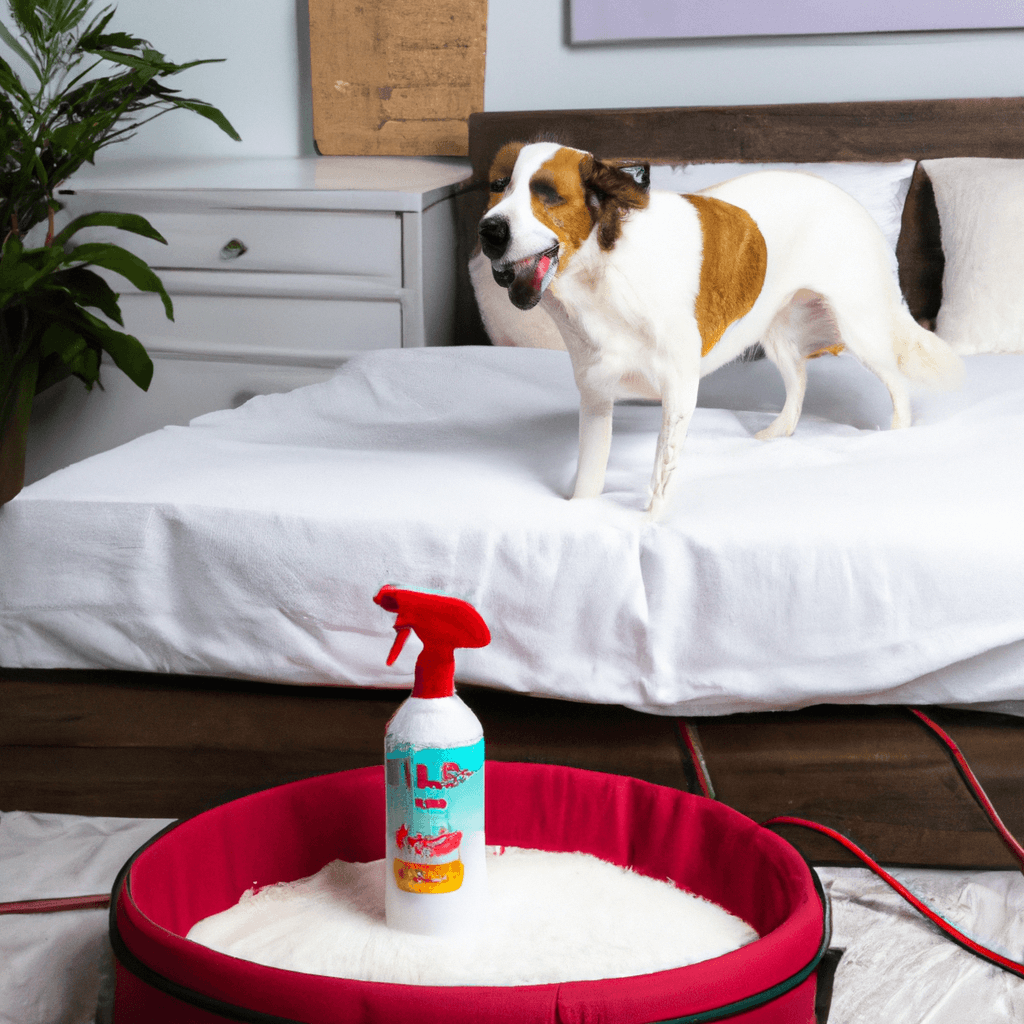Lysol is a popular household cleaner, but can it be safely used on a dog bed? Many pet owners are often concerned about the safety of using Lysol on their pet’s bed. While Lysol is a great disinfectant, it can be toxic if used improperly.
Therefore, it is important to understand how to safely use Lysol on a dog bed. This article will provide an overview of the safety of using Lysol on a dog bed, as well as some tips for using Lysol safely and effectively.
How to Keep Your Dog’s Bed Clean and Sanitized with Lysol
If your pup has an indoor bed, it’s important to keep it clean and sanitized. After all, you don’t want your pet to be sleeping on a bed filled with germs and bacteria. Thankfully, it’s easy to keep your pup’s bed clean and sanitized with Lysol. Here’s how:
- Start by vacuuming the bed. This is especially important if your pup has long fur. Vacuuming will remove any dirt, hair, and debris from the bed.
- Once you’ve finished vacuuming, spray the bed with Lysol, making sure to cover every inch of the bed. Leave the Lysol to work its magic for a few minutes before wiping it down with a damp cloth.
- Once you’ve wiped down the bed, it’s time to wash it. Remove the bedding (if applicable) and place the bed in the washing machine. Set the washer on a delicate cycle and use a mild detergent.
- Once the bed is finished washing, hang it up to dry. Be sure to keep it in a well-ventilated area, as this will help the bed dry faster.
- Once the bed is dry, spray it down with Lysol again and wipe it down with a damp cloth. This will help ensure that the bed is thoroughly sanitized.
Following these steps will help keep your pup’s bed clean and sanitized. It’s important to do this regularly, especially if your pup tends to spend a lot of time in their bed. Of course, if you have any concerns, always consult your veterinarian.
What to Know Before Spraying Lysol on Your Dog’s Bed
Spraying Lysol on your dog’s bed may seem like an easy way to keep it clean, but there are a few things to consider before taking this approach. First, make sure that your dog is not in the area when you are spraying Lysol.
The fumes can be an irritant and could make your pup ill. It’s also important to make sure your pup is not in the area while the Lysol is still wet, as the liquid can be toxic if ingested. When spraying Lysol on your dog’s bed, you should also make sure to use a diluted solution.
The label should indicate what ratio of Lysol to water should be used. Too much Lysol can be dangerous, so make sure to follow the instructions carefully. You should also avoid spraying Lysol on any materials that can be damaged by liquids, such as fabrics and soft cushions.
The Lysol can cause them to discolor or shrink. And finally, after you’ve sprayed the bed, make sure to let it dry completely before letting your pup back in the area. Spraying Lysol on your dog’s bed can be a great way to keep it clean and fresh, but it’s important to take the proper precautions and follow the instructions on the label.
Tips to Help Your Dog Feel Safe and Secure in a Lysol-Sprayed Bed
- Make sure you spray the bed with Lysol in a well-ventilated room, and make sure your dog is not present when you are spraying the bed.
- Allow the bed to air out for at least an hour before allowing your dog to get on it.
- Consider using a dog bed cover to help contain the Lysol odor.
- Place the bed in a comfortable, quiet spot where your dog feels safe and secure.
- Give your dog his favorite blanket or toy to lay on top of the Lysol-sprayed bed to help him adjust to the smell.
- Give your dog plenty of positive reinforcement when he gets on the bed and spends time there.
- Make sure your dog has access to plenty of fresh, clean water and a comfortable spot to sleep away from the Lysol-sprayed bed if needed.
- If your dog is still uncomfortable or reluctant to sleep on the Lysol-sprayed bed, consider using a different type of disinfectant that won’t have such a strong smell.
Reasons to Disinfect Your Dog’s Bed with Lysol
- Keeps your pup healthy: Disinfecting your pup’s bed with Lysol is an easy and effective way to help keep your pup healthy. By eliminating germs, bacteria, and other nasty things, you can help prevent your pup from getting sick.
- Keeps your home clean: Not only can Lysol help keep your pup healthy, but it can also help keep your home clean. By using Lysol to disinfect your pup’s bed, you can help reduce the amount of dirt, dust, and bacteria that can be tracked into your home from your pup’s bed.
- Prevents odors: By using Lysol to disinfect your pup’s bed, you can help prevent bad odors from lingering in your home. Lysol can help eliminate any odors that may be coming from your pup’s bed.
- Helps alleviate allergies: If you or someone in your home suffers from allergies, Lysol can be a great way to help alleviate their symptoms. By reducing the amount of dust, pollen, and other allergens on your pup’s bed, you can help reduce the number of allergens in the air.
What You Should Know About the Safety of Spraying Lysol on Your Dog’s Bed
Spraying Lysol on your dog’s bed might sound like a good idea to keep it clean and free of germs, but you should think twice before doing it. While Lysol may be great for disinfecting hard surfaces, it can be dangerous for your pup if you’re not careful.
First, many of the ingredients in Lysol are toxic to animals if ingested. If your pup licks the surface of its bed after you’ve sprayed it with Lysol, it could get sick. That’s why it’s always important to thoroughly rinse any surface you spray with Lysol and make sure it’s completely dry before your pup has access to it.
Second, Lysol can cause skin irritation in animals. If your pup has sensitive skin, the chemicals in Lysol could cause redness, itching, or even a rash. If you want to use Lysol on your pup’s bed, make sure to dilute it in water first and test it on a small area of the bed before spraying it all over.
Finally, Lysol is an aerosol spray, so it can be harmful to your pup’s respiratory system if inhaled directly. If you do decide to use Lysol on your pup’s bed, make sure to do it in a well-ventilated area and keep your pup away from the bed until it’s completely dry.
In short, while Lysol can be a great way to keep your pup’s bed clean, it’s important to be aware of the potential risks it poses before spraying it on your pup’s bed. If you take the necessary precautions, you can help ensure that your pup stays safe and healthy.
How to Choose the Right Lysol Product to Safely Sanitize Your Dog’s Bed
Sanitizing your dog’s bed is essential for keeping it clean and free of germs and bacteria. Lysol products are great for sanitizing, but it’s important to choose the right one. Here’s how to do it.
- Read the label: Before you buy any Lysol product, make sure to read the label to make sure it is safe to use on the material your dog’s bed is made of. Different Lysol products are designed to be used on different surfaces, so make sure you choose the right one.
- Choose a disinfectant: Lysol offers a variety of products, including sprays, wipes, and liquids. Of these, a disinfectant is the best choice for sanitizing your dog’s bed. A disinfectant will kill germs and bacteria while also reducing odors.
- Choose an odor-removing product: If your dog’s bed has an unpleasant odor, choose a Lysol product that is specifically designed to eliminate odors. This will help keep your dog’s bed smelling fresh and clean.
- Follow the instructions: Once you have chosen the right Lysol product, make sure to follow the instructions carefully. This will ensure that your dog’s bed is properly sanitized and that you are using the product safely.
By following these tips, you can choose the right Lysol product to safely sanitize your dog’s bed. With the right product, you can keep your pup’s sleeping spot clean and free of germs and odors.
Is It Necessary to Clean Your Dog’s Bed with Lysol?
No, it is not necessary to clean your dog’s bed with Lysol. In fact, Lysol is not a good cleaning product to use on a pet bed. Lysol is designed to kill germs and bacteria, but it also contains harsh chemicals that can irritate your dog’s skin and respiratory system.
Additionally, Lysol is not designed to be used on pet beds, so it may not be effective at cleaning your pet’s bed. Instead, the best way to clean your pet’s bed is to use mild detergent and warm water.
Make sure to read the washing instructions on the bed’s label before washing it. If the bed is filled with stuffing or other materials, you may need to vacuum it first. Once you have washed the bed, air dry it completely before giving it back to your dog.
How to Clean and Deodorize Your Dog’s Bed with Lysol
Cleaning and deodorizing your dog’s bed is a great way to keep your pup safe and healthy. With Lysol, it’s easy to get rid of bacteria and odors that can accumulate in your pet’s bed. Here’s how to do it right:
- Vacuum the bed. Before you start cleaning, use a vacuum cleaner to remove any pet fur, dust, and other debris from the surface of the bed.
- Prepare Lysol solution. Fill a spray bottle with one part Lysol and four parts water. Shake it well to ensure the solution is mixed properly.
- Spray the bed. Lightly mist the bed with the Lysol solution. Make sure you cover the entire surface, including the seams and crevices.
- Wipe the bed. Use a damp cloth to wipe the bed down. This will help remove any dirt and debris that the Lysol didn’t get.
- Let the bed dry. Allow the bed to air dry completely before putting it back in your pup’s area. With just a few simple steps, you can keep your pup’s bed clean and smelling fresh with Lysol.
What to Do If You Accidentally Get Lysol on Your Dog’s Bed
If you accidentally get Lysol on your dog’s bed, don’t panic! In most cases, it won’t hurt your pup, but it’s important to clean it up as quickly as possible. Here’s what you should do:
- If you’ve just sprayed the Lysol, take the bed outside and let it air out. This will help to get rid of any of the fumes that could be harmful to your dog.
- Once the bed has aired out, you can start to clean it. Use a mild detergent and warm water to spot-clean the area where the Lysol was sprayed.
- Use a wet cloth to rinse away any soap residue and let the bed dry completely.
- Once the bed is dry, it should be safe for your pup to use again.
While Lysol is generally safe for use around pets, it’s important to be careful not to get it on their beds or anywhere else they spend a lot of time. Always read the label to make sure you are using the product correctly. If you accidentally get Lysol on your dog’s bed, following these steps will help keep your pup safe.
1 How Often Should You Spray Lysol on Your Dog’s Bed?
It’s not recommended to spray Lysol on your dog’s bed. While Lysol can kill many germs, it can also be toxic to pets and can cause skin, eye, and respiratory irritation. Instead, it’s best to use an upholstery cleaner specifically designed for pet beds. These products are designed to be safe for both pets and their bedding.
Additionally, you should wash your dog’s bed regularly to help keep it clean and free of germs. Depending on how often your pup uses the bed, it can be washed anywhere from weekly to monthly.
In conclusion, it is generally not recommended to spray Lysol on a dog bed because the chemicals could be harmful to your pet. It is better to use a pet-safe disinfectant and vacuum the bed regularly to keep it clean and hygienic.




